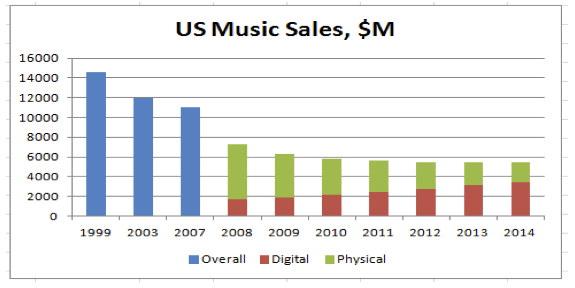As technology continues to be one of the “key” driving forces behind the evolution of the music industry, there are signs that consumers may not be paying for recorded music in the future —thus, will the old monetizations models for artists and labels still work? Better yet are they working now?
When the dust finally settles between the artists, labels, and distribution companies, we feel that the importance of artist to fan relationships will more than likely emerge as being more valuable than recorded music itself.
As we can see from the chart below, traditional monetization models for recorded music sales have been steadily declining. Total revenues for CDs, vinyl, cassettes, and digital downloads worldwide dropped 25 percent from $38.6 billion in 1999 to $27.5 billion in 2008, according to the International Federation of the Phonographic Industry (IFPI). The same revenues in the U.S. dropped from a high of $14.6 billion in 1999 to $10.4 billion in 2008.
While digital music sales have been on the rise in recent years, they have only partially replaced physical sales, so the overall sales figures are still headed south. And it surely isn’t because people are listening to less music. It’s simply because the old adage holds true: why pay for something that you can get for free? In addition, artists, the ones with the talent, aren’t making money off digital sales. Artists get about $0.09 per song sold digitally on iTunes or Amazon. So for a million downloaded hits, an artist earns about $90K. Subtract manager, lawyer, agent and other “fees,” and what is left for the artist selling one million downloads is minimal.
Already, there is a deluge of great (and legal!) sites providing free music — including Pandora, YouTube, Spotify, Grooveshark, MOG, Rdio, and other online destinations. This is a big change from the early days of online music, when free meant illegal. Today, music start-ups have caught on to the profit potential in “giving it away.” Companies like Pandora, which generated $67M of revenue in 2011 Q2, and Spotify with over two million paying users, don’t charge for entry-level service. Instead, these music innovators found a way to monetize music indirectly through advertising and other means. Music still comes at great cost — start-ups still pay high licensing fees to labels — but as the economics shift, licensing fees are likely to decline. (Yes, labels will do a lot of kicking and screaming.)
Source: CNN, Forrester
The bottom line is, music is getting closer and closer to free and we anticipate a lot of “creative” changes to the value model based on fan-driven music marketing models. Distribution is becoming commoditized, so monetization must change. To this end, artists will have to develop innovative ways to engage with fans more directly, and actively seek out fans and benefactors willing to pay more than usual for their work. The music startups that will make money over the long term are those that will connect artists with fans, help people filter and discover new music they love, and offer unique experiences. People will never stop listening to music — they’ll just change how they find it, hear it, and pay for it.
So what are these new and innovated ways that artists can monetize their music? Contact Us.
